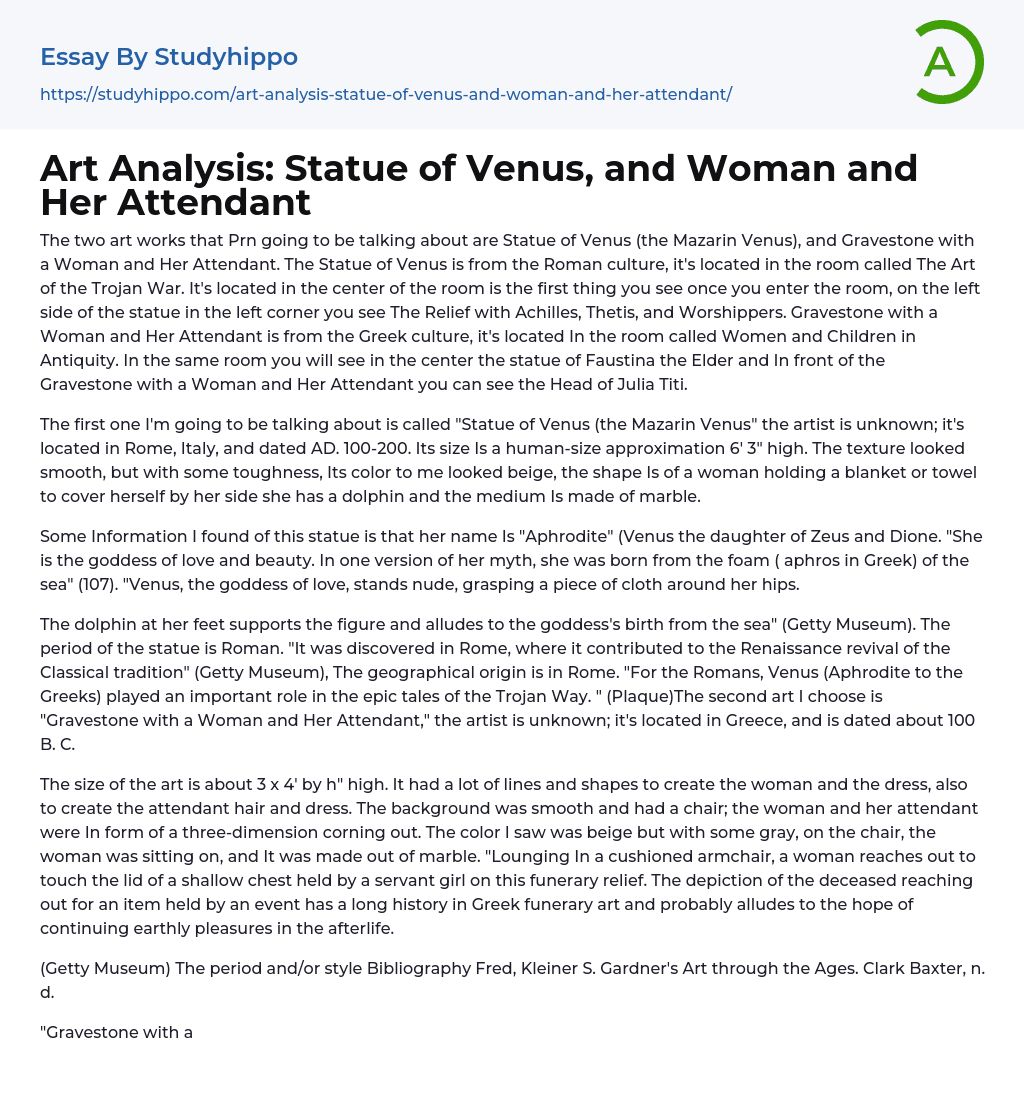

Art Analysis: Statue of Venus, and Woman and Her Attendant Essay Example
The two art works that Prn going to be talking about are Statue of Venus (the Mazarin Venus), and Gravestone with a Woman and Her Attendant. The Statue of Venus is from the Roman culture, it's located in the room called The Art of the Trojan War. It's located in the center of the room is the first thing you see once you enter the room, on the left side of the statue in the left corner you see The Relief with Achilles, Thetis, and Worshippers. Gravestone with a Woman and Her Attendant is from the Greek culture, it's located In the room called Women and Children in Antiquity. In the same room you will see in the center the statue of Faustina the Elder and In front of the Gravestone with a Woman and Her Attendant you can
...see the Head of Julia Titi.
The first one I'm going to be talking about is called "Statue of Venus (the Mazarin Venus" the artist is unknown; it's located in Rome, Italy, and dated AD. 100-200. Its size Is a human-size approximation 6' 3" high. The texture looked smooth, but with some toughness, Its color to me looked beige, the shape Is of a woman holding a blanket or towel to cover herself by her side she has a dolphin and the medium Is made of marble.
Some Information I found of this statue is that her name Is "Aphrodite" (Venus the daughter of Zeus and Dione. "She is the goddess of love and beauty. In one version of her myth, she was born from the foam ( aphros in Greek) of the sea" (107). "Venus, the goddess
of love, stands nude, grasping a piece of cloth around her hips.
The dolphin at her feet supports the figure and alludes to the goddess's birth from the sea" (Getty Museum). The period of the statue is Roman. "It was discovered in Rome, where it contributed to the Renaissance revival of the Classical tradition" (Getty Museum), The geographical origin is in Rome. "For the Romans, Venus (Aphrodite to the Greeks) played an important role in the epic tales of the Trojan Way. " (Plaque)The second art I choose is "Gravestone with a Woman and Her Attendant," the artist is unknown; it's located in Greece, and is dated about 100 B. C.
The size of the art is about 3 x 4' by h" high. It had a lot of lines and shapes to create the woman and the dress, also to create the attendant hair and dress. The background was smooth and had a chair; the woman and her attendant were In form of a three-dimension corning out. The color I saw was beige but with some gray, on the chair, the woman was sitting on, and It was made out of marble. "Lounging In a cushioned armchair, a woman reaches out to touch the lid of a shallow chest held by a servant girl on this funerary relief. The depiction of the deceased reaching out for an item held by an event has a long history in Greek funerary art and probably alludes to the hope of continuing earthly pleasures in the afterlife.
(Getty Museum) The period and/or style Bibliography Fred, Kleiner S. Gardner's Art through the Ages. Clark Baxter, n. d.
"Gravestone with a Woman and Her
Attendant (Getty Museum). " Gravestone with a Woman and Her Attendant (Getty Museum). N. p. , n. d.
Web. 01 Aug. 2013. "Statue of Venus (the Mazarin Venus) (Getty Museum).
" Statue of Venus (the Mazarin Venus) (Getty Museum). N. p. , n.
d. Web. 01 Aug. 2013.
- Architecture essays
- Design essays
- Graffiti essays
- Graphic essays
- Interior design essays
- Painting essays
- Photography essays
- Sculpture essays
- Typography essays
- Agriculture essays
- Albert einstein essays
- Animals essays
- Archaeology essays
- Bear essays
- Biology essays
- Birds essays
- Butterfly essays
- Cat essays
- Charles Darwin essays
- Chemistry essays
- Dinosaur essays
- Discovery essays
- Dolphin essays
- Elephant essays
- Eli Whitney essays
- Environmental Science essays
- Evolution essays
- Fish essays
- Genetics essays
- Horse essays
- Human Evolution essays
- Isaac Newton essays
- Journal essays
- Linguistics essays
- Lion essays
- Logic essays
- Mars essays
- Methodology essays
- Mineralogy essays
- Monkey essays
- Moon essays
- Mythology essays
- Noam Chomsky essays
- Physics essays
- Plate Tectonics essays
- Progress essays
- Reaction Rate essays
- Roman Numerals essays
- Scientific essays
- Scientific Method essays



